The Sempervirens Score Method
1. THE IMPORTANCE OF ASSESSING THE SUSTAINABILITY OF VITICULTURAL OPERATIONS
1.1 General Framework of the Approach
Environmental preservation is a major challenge, with numerous international initiatives covering a wide range of objectives.
The 17 Sustainable Development Goals (SDGs) are to be implemented by all United Nations member states.
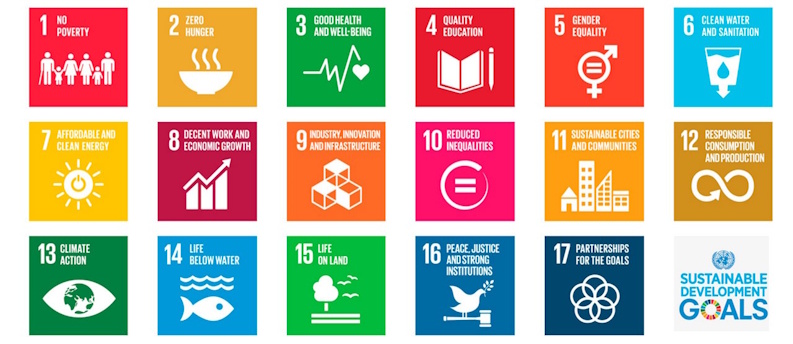
This area represents 3% of France’s cultivated land but generates 15% of agricultural revenue, or €12.5 billion in production. French viticulture is a major economic sector. The wine and vine industry generates €60 billion in revenue, and with related sectors, a total of €92 billion. Wine and brandy exports amount to 2 billion bottles shipped to over 200 countries, making wines and spirits the second-largest contributor to France’s trade balance, behind aeronautics and ahead of cosmetics, with €12.7 billion. In terms of employment, viticulture supports nearly 500,000 direct and indirect jobs across France.
1.2 The Need for Comprehensive Assessment Tools for Sustainability Diagnosis
2. THE SEMPERVIRENS METHOD
2.1 Objectives and Ambitions
The Sempervirens Score aims to measure the environmental impact of viticultural activities. It seeks to provide stakeholders, including consumers, with a clear overview of wine’s impacts.
The evaluation raises awareness among all actors in the value chain, serving a pedagogical purpose. By comparing systems and actors, it provides insights to easily identify areas for improvement. It also encourages companies to progress toward other available tools for deeper analysis.
The Sempervirens Score is designed as a first step, encouraging some actors to conduct a full Carbon Footprint®, others to undertake an IDEA4 audit, or pursue other initiatives based on their performance, motivation, sensitivity, and resources. The score aims to drive action for improvement, thereby reducing environmental impacts.
2.2 Conceptual Framework
The Sempervirens Score aligns with 8 of the 12 sustainable agriculture objectives:
- Preserve natural resources (biodiversity, soil, water, and air)
- Conserve non-renewable resources
- Preserve and/or enhance landscapes
- Address climate change (mitigation and adaptation)
- Contribute to food security and sovereignty
- Support employment and territorial development
- Ensure economic viability and farm sustainability
- Contribute to quality of life
- Maintain freedom of action and independence
- Engage in responsible initiatives or commitments
- Ensure animal welfare
- Produce and share knowledge and expertise
Focused on the environment, it encourages the viticulture sector to contribute to staying within planetary boundaries.
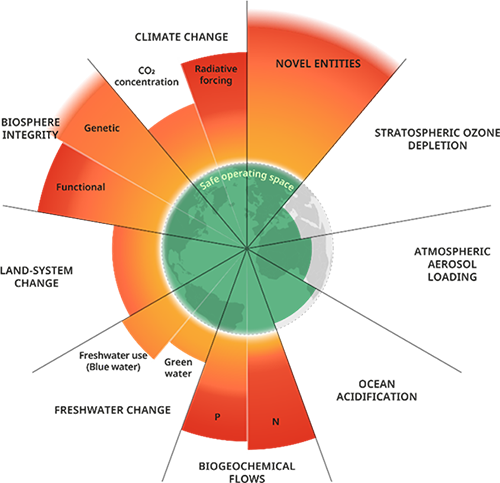
The viticulture sector can thus help minimize impacts on:
- Climate change (GHG concentrations)
- Biodiversity
- Land use
- Freshwater (green and blue water)
- Disruption of cycles (nitrogen and phosphorus)
- Chemical pollution
It aligns with the 5 environmental themes of the CSRD:
- E1: Climate change (GHG)
- E2: Pollution
- E3: Water and marine resources
- E4: Biodiversity and ecosystems
- E5: Resource use and circularity
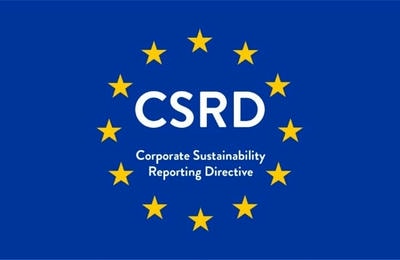
These 5 themes form the 5 sub-scores that, when aggregated, constitute the Sempervirens Score of the evaluated company.
2.3 Scope of Analysis
The Sempervirens Score measures the environmental impact of viticultural business models, adapting to their diversity. It is designed to be displayed on product packaging and direct consumers to a detailed score breakdown on the Sempervirens Score website.
Within the viticulture value chain, it covers all stages from vineyard to winery up to the product leaving the company that bottled it. It is not a full life cycle analysis (LCA), as it excludes final distribution. This aspect will be addressed in future methodology updates (see below).
The score is tailored to different wine production models: single growers, cooperative wineries using grapes from multiple growers, and négociants (purchasing grapes or must). For the latter, the score requires access to necessary data from all grape and must suppliers.
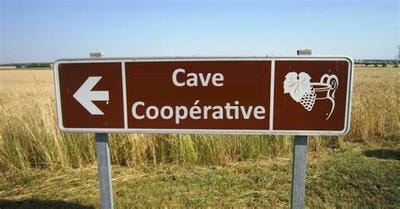
3. SCORE CALCULATION
The Sempervirens Score rates a winery’s sustainability performance on a 100-point scale.
Five themes are evaluated, each with different weights. Each theme has its own methodology.
The score is the sum of the 5 theme sub-scores.
3.1 The Two Dimensions of the Score
The Sempervirens Score is presented in two dimensions:
- Weight of the 5 themes: Represented graphically by the width of each segment, fixed and identical for all scores.
- Performance in each theme: Represented by the length of the segment’s radius. For example, a score of 20/40 is shown as 50% of the maximum radius length.
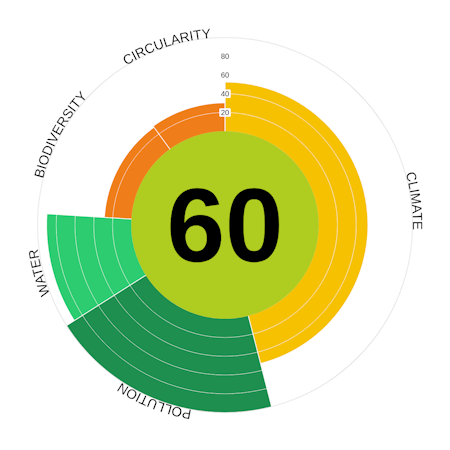
3.2 Score Hierarchy
The total score is the sum of the 5 theme scores, providing a snapshot of the winery’s environmental impact.
Six levels are calibrated, from highest to lowest environmental impact:
| Score Range | Environmental Impact |
|---|---|
| 0 – 20 | Very High |
| >20 – 40 | High |
| >40 – 60 | Medium |
| >60 – 80 | Low |
| >80 – 95 | Near Zero |
| >95 | Regenerative |
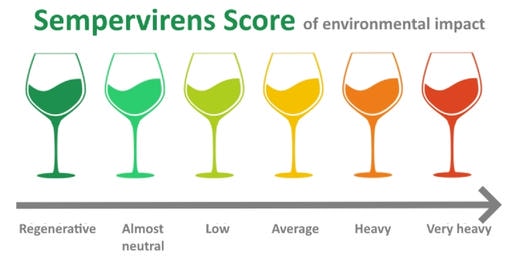
The higher the impact, the greater the potential for improvement. The goal is to help wineries achieve at least a “Low” environmental impact.
3.3 Weighting of the 5 Environmental Themes
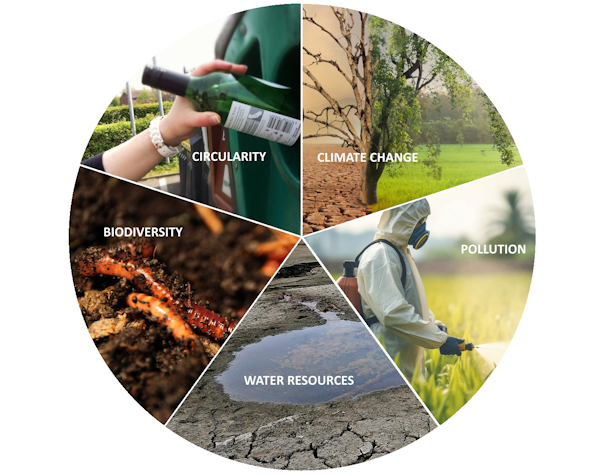
The weights for each theme are:
- Climate: 40%
- Pollution: 20%
- Water: 10%
- Biodiversity: 20%
- Circularity: 10%
These weights reflect the relative importance of each theme, tailored to viticultural business models. Different crops might require different weightings.
Expert opinions may vary on the relative importance of these criteria.
Climate (40%): Human-induced GHG emissions, including those from alcoholic fermentation, are a primary environmental concern. Viticulture emits carbon but can also sequester it, like other agricultural activities.
Pollution (20%): The use of phytosanitary products in viticulture often exceeds that of other crops, impacting soils, water, and food products.
Water (10%): Water is central to environmental issues, as both cause and consequence. While vines use less water than other crops, consumption occurs in both vineyards and wineries.
Biodiversity (20%): The collapse of biodiversity, particularly in soils, is a key focus of the score.
Circularity (10%): This considers the circularity of containers and the management of pruning waste, lees, and must.
3.4 Climate
GHG emissions are the starting point for environmental analysis. Since many wineries have not conducted a Carbon Footprint®, it is not a prerequisite for the score.
However, existing GHG studies are used to validate the score’s methodology. The Sempervirens Score is a simplified version of the Carbon Footprint, focusing on key GHG emission sources in viticulture:
- Glass containers: Account for about half of the sector’s emissions. The weight of glass bottles and the type (clear or tinted) are considered. The carbon footprint per liter of beverage produced is calculated based on the glass used in the reference year.
- Energy consumption: Includes electricity, fuel oil (all forms), and gas (natural, butane, propane) based on supplier invoices and self-production records. The carbon footprint per liter is added to the total.
- Fixed assets: Buildings and winery equipment can be significant emission sources. The score considers the surface area of buildings constructed in the last 20 years (amortized over 20 years) and investments from the last 10 years (amortized over 10 years). The carbon footprint per liter is added.
- Total carbon footprint: Expressed in kg CO2e/l, scored out of 33. A footprint below 0.6 kg CO2e/l earns the maximum score; above 2.45 kg CO2e/l scores 0.
- Vehicles: Includes owned and leased vehicles used in vineyards (e.g., refrigerated trucks during harvest). Vehicle type and age are weighted based on vineyard area (ha).
- Weights range from 1 (Class 1 agricultural vehicle) to 10 (thermal truck >7.5 tons), using the Carbon Footprint® nomenclature. Scored out of 7.
The ADEME emission database is used for GHG calculations.
3.5 Pollution
Pollution primarily concerns air, water, and soil, mainly from synthetic inputs in vineyards.
The score relies on the type of farming, certified by labels, which regulate input types and volumes:
- Conventional or “reasoned” agriculture: 0 points
- HVE or Terra Vitis labels: 5 points
- Transition to organic (AB) certification: 10 points
- Organic agriculture: 18 points
- Biodynamic labels (more restrictive in the winery): 20 points
Scores are weighted by the area (ha) for estates with mixed farming types.
3.6 Water
Water use in vineyards and wineries is evaluated based on the volume used per liter of beverage produced, scored from 10 (less than 0.6 l water/l beverage) to 0 (more than 11 l water/l beverage).
- Vineyard water: Used for irrigation, spraying, or frost protection. The volume is weighted by source (municipal water, groundwater, surface water, rainwater storage) and whether the vineyard is in a water-conflict zone.
- Winery water: Mainly used for cleaning (e.g., tanks).
The score uses water bills, domain water extraction records, and storage volumes to calculate total water use.
3.7 Biodiversity
Biodiversity preservation and ecosystem services are critical for agriculture. The score assesses two aspects:
- Soil biodiversity in vineyards:
- Based on soil studies, focusing on pH, C/N ratio, and organic matter content per plot, compared to expected values for the soil type. Scored out of 8.
- Soil compaction: Scored out of 2, based on the number and weight of machine passes in the vineyard. Fewer passes reduce compaction risk.
- Non-vineyard land managed by the estate:
- Permanent woods and fallows: Encourages areas left for biodiversity (woods, fallows, permanent meadows). Scored out of 2 based on the ratio of cultivated to fallow land.
- Vineyard cover cropping: Benefits soil biodiversity, auxiliaries, and water retention. The cover cropping strategy and duration relative to area are scored out of 8.
3.8 Circularity
Circularity examines the use of recycled resources and waste management.
The score focuses on three criteria:
- Pruning waste: Best practice is leaving it in place; worst is burning. Scored out of 2.
- Production waste (lees and pomace): Best practice is spreading on-site; worst is disposal at a landfill. Scored out of 2.
- Container circularity: Organized bottle deposit systems score highest. Recycling of other containers is also weighted. Scored out of 6.
4. LIMITATIONS AND FUTURE DEVELOPMENTS
4.1 Limitations
The Sempervirens Score is designed to be easy to calculate and enable comparisons. It is not exhaustive or perfect, but it targets the 20% of criteria that address 80% of the issues studied.
Known limitations are acknowledged for each criterion. None of the 5 environmental themes are fully comprehensive, but the score captures their major elements. Practices are comparable, enabling useful insights for participating estates.
The separation of the 5 themes is not absolute. For example, pruning waste management (circularity) affects the carbon footprint through potential carbon sequestration. Feedback loops exist, e.g., poorly managed lees and pomace spreading can cause pollution. The “Do No Significant Harm” (DNSH) principle guides the score, rejecting unacceptable practices even if others are virtuous.
4.2 Future Developments
Like any environmental indicator, the Sempervirens Score will evolve: To incorporate new knowledge and refine weightings and scores.
To use more precise data (e.g., using actual carbon footprints from equipment manufacturers instead of theoretical values).
To adapt to emerging business models, such as agroforestry.
The Sempervirens Scientific Committee and feedback from estates will prioritize updates.
Suggestions for improvement can be submitted via the contact form.
